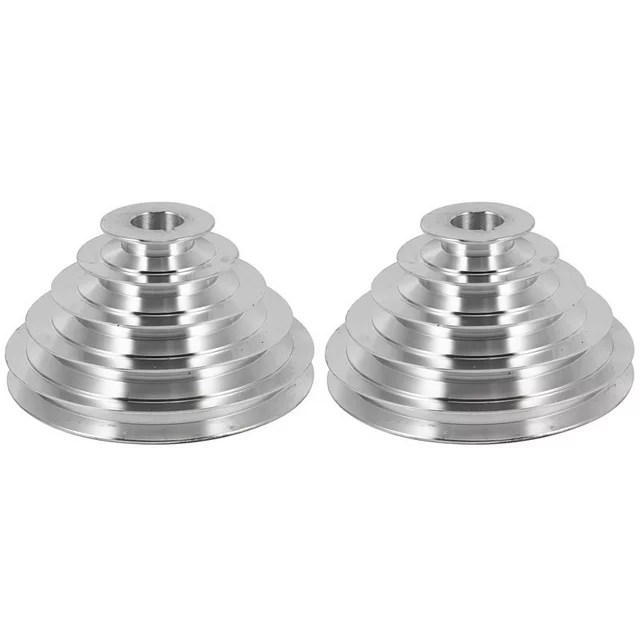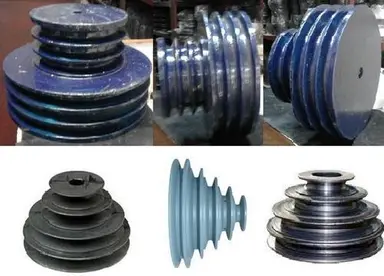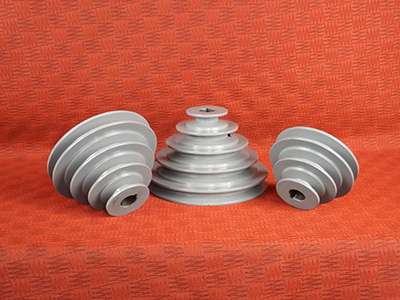Product Description
Step Pulley Adjustable Wheel Lock Bushes Metal Bore Sprocket Gear Transmission Machine Parts Manufacture Best Sale Durable European Standard Durable Pulleys
step pulley
A series of pulleys of various diameters combined in a single concentric unit is knows as step pulley and used to vary the velocity ratio of shafts. Step Pulley is used where variations are required from slow rotations to high rotations with change of torque. It is also known as cone pulley.
Also known as step-cone pulleys, these have multiple groove sizes so you can quickly change rotation speed by moving your belt to a different groove. Use with fractional-horsepower motors for drives with frequent speed changes.
| Certification: | CE, ISO |
|---|---|
| Pulley Sizes: | Type F |
| Manufacturing Process: | Forging |
| Material: | Carbon Steel |
| Surface Treatment: | Baking Paint |
| Application: | Chemical Industry, Grain Transport, Mining Transport, Power Plant |
| Samples: |
US$ 9999/Piece
1 Piece(Min.Order) | |
|---|

What maintenance procedures are necessary to ensure the reliability of step pulleys?
To ensure the reliability of step pulleys, certain maintenance procedures should be followed. Here are some essential maintenance procedures:
1. Regular Inspection:
Perform regular visual inspections of the step pulleys to check for any signs of wear, damage, or misalignment. Look for cracks, chips, or excessive wear on the pulley steps. Ensure that the pulley is properly aligned with the belt or cable and that there is no excessive play or wobbling.
2. Lubrication:
Proper lubrication is crucial for the smooth operation of step pulleys. Follow the manufacturer’s guidelines on lubrication frequency and use the recommended lubricant. Apply lubricant to the pulley shaft and bearings to reduce friction and prevent premature wear.
3. Belt or Cable Maintenance:
Inspect the belts or cables regularly for signs of wear, cracking, or stretching. Replace any worn-out or damaged belts or cables promptly. Ensure that the belts or cables are correctly tensioned and properly aligned with the step pulleys to prevent slippage and optimize power transmission.
4. Cleaning:
Keep the step pulleys clean and free from debris, dust, or other contaminants. Regularly clean the pulleys using a soft brush or cloth to remove any buildup that may affect their performance. Avoid using harsh chemicals that could damage the pulley surface or belt material.
5. Belt Alignment:
Check the alignment of the belts or cables on the step pulleys. Misaligned belts can cause uneven wear, increased friction, and reduced efficiency. Adjust the pulley position or tension as necessary to ensure proper alignment.
6. Preventive Maintenance:
Implement a preventive maintenance schedule for the machinery that includes step pulleys. Schedule periodic maintenance tasks, such as pulley inspections, lubrication, and belt or cable replacements, to prevent unexpected failures and ensure the long-term reliability of the pulleys.
7. Professional Expertise:
For complex machinery or critical applications, it is advisable to seek the expertise of qualified technicians or maintenance professionals. They can provide specialized knowledge and perform more in-depth maintenance procedures to ensure the reliability and optimal performance of the step pulleys.
By following these maintenance procedures, step pulleys can be kept in good condition, minimizing the risk of failures, optimizing performance, and extending their service life.

How do step pulleys enhance the precision and versatility of machinery and equipment?
Step pulleys play a crucial role in enhancing the precision and versatility of machinery and equipment in various industries. Here are some ways in which step pulleys provide these benefits:
1. Speed Control:
Step pulleys allow for precise speed control in machinery and equipment. By changing the position of the belt on different steps of the pulley, operators can adjust the rotational speed of the driven components. This enables fine-tuning of the machine’s performance to match the specific requirements of the task at hand.
2. Variable Speed Options:
With multiple steps on the pulley, each corresponding to a different speed ratio, step pulleys provide a range of variable speed options. This versatility allows operators to select the most suitable speed for different materials, cutting tools, or processes. It enables customization and optimization of the machine’s performance based on specific applications.
3. Adaptability to Different Materials:
Step pulleys enhance the versatility of machinery by accommodating different materials and workpieces. Different materials often require different cutting speeds or rotational speeds for optimal results. By adjusting the step pulley configuration, operators can easily adapt to various materials, allowing the machine to work efficiently across a wide range of applications.
4. Power Transmission Efficiency:
Step pulleys contribute to power transmission efficiency in machinery and equipment. By selecting the appropriate step and corresponding belt position, the pulley ensures that the power is transmitted efficiently from the driving source to the driven components. This optimization minimizes energy loss and enhances the overall performance of the machine.
5. Precise Control over Operations:
Step pulleys enable precise control over the operations performed by machinery and equipment. The ability to adjust the rotational speed of cutting tools, workpieces, or other driven components allows operators to achieve accurate and consistent results. This precision is vital in applications such as machining, printing, and other processes that require tight tolerances and high-quality outputs.
6. Versatile Applications:
Step pulleys find applications in various industries and machinery types, making them highly versatile components. They are used in machines such as drill presses, lathes, milling machines, automotive transmissions, exercise equipment, and more. This versatility enhances the range of tasks that can be performed by a single machine, making it adaptable to different production requirements.
7. Cost-Effective Solution:
Step pulleys offer a cost-effective solution for achieving variable speed control in machinery and equipment. Compared to more complex speed control mechanisms, step pulleys are relatively simple, reliable, and cost-efficient. They provide an efficient means of adjusting speed without requiring extensive modifications or additional components.
By providing precise speed control, variable speed options, adaptability to different materials, power transmission efficiency, and versatile applications, step pulleys significantly enhance the precision and versatility of machinery and equipment. Their contribution to optimizing performance and achieving high-quality outputs makes them indispensable components in various industries.

In which industries and applications are step pulleys commonly used?
Step pulleys find widespread use in various industries and applications where adjustable speed control is required. Here are some industries and applications where step pulleys are commonly used:
1. Machine Tools:
Step pulleys are extensively used in machine tools such as drill presses, milling machines, and lathes. They allow operators to adjust the rotational speed of cutting tools, enabling precise machining operations.
2. HVAC Systems:
Heating, ventilation, and air conditioning (HVAC) systems often utilize step pulleys in blower motors and fans. These pulleys enable adjusting the speed of the fan to control airflow and temperature regulation.
3. Automotive Industry:
Step pulleys are employed in various automotive applications. They can be found in engine accessories like alternators and power steering systems, where they allow for adjustable speed control.
4. Industrial Machinery:
Step pulleys are used in a wide range of industrial machinery, including conveyors, packaging machines, textile machines, and printing presses. They provide speed variation for different production requirements.
5. Exercise Equipment:
Step pulleys are utilized in exercise equipment like treadmills, stationary bikes, and elliptical machines. They allow users to adjust the difficulty level and intensity of their workouts by changing the speed or resistance.
6. Garage Door Openers:
Step pulleys are commonly found in garage door openers. They enable smooth and controlled opening and closing of garage doors by adjusting the speed and torque applied to the door mechanism.
7. Textile Industry:
In textile manufacturing, step pulleys are used in textile machines such as spinning frames and weaving looms. They provide speed control for various stages of the textile production process.
8. Woodworking Machinery:
Step pulleys are utilized in woodworking machinery, including table saws, band saws, and sanding machines. They enable operators to adjust the speed of cutting or sanding tools for different types of wood and desired finishes.
These are just a few examples, and step pulleys can be found in numerous other industries and applications where adjustable speed control is essential.


editor by CX
2023-10-08
